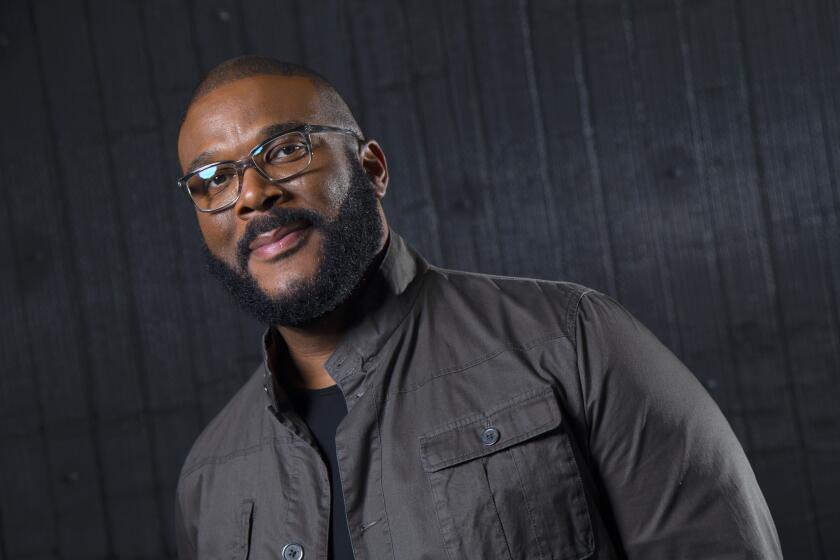Artists Depict the Holocaust From Different Perspectives
- Share via
The current show at the University of Judaism’s Platt Gallery is titled “Yom Ha Shoah,” which is Hebrew for Holocaust remembrance day. But the five-artist exhibition’s real thematic fiber has to do with remembrances once-removed, filtered through the rage and lingering memories of the next generation, children of survivors.
Beyond that, the unstated message of this art has to do with remembering to remember, on the occasion of the 50th anniversary of the Holocaust.
Artists choosing to deal with a topic so ineffably horrific as the Holocaust face a challenge of how to effectively convey feelings of deep, race-specific anguish. The artists here approach this difficult terrain from different angles, and with different degrees of metaphorical distance from the gruesome reality.
Sculptor Tom Wolver seizes on the unambiguous image of bones--scorched and dismantled skeletal fragments. Sometimes, these composite skeletal forms yield further impressions, as in “Ruins of the Heart,” in which a woman’s skeletal frame seems to be giving birth to figures already howling in pain, like the brutal residue of borrowed memory about the genocide.
Harry Lesch’s photographs take Wolver’s sculptures one step further by superimposing images of fire over their skeletal remains. The photographs evoke the horror telegraphically, in an area where subtlety would be gratuitous.
Lucille Dratler, a child of a Holocaust survivor, deals with the pained, yearning relationship of one aggrieved generation to the next. In “Warmth,” an infant is held by a mother who is nothing more than a skeleton, while “Want” depicts a baby’s tender, fleshy hand reaching out across a dark chasm to an adult’s skeletal hand branded with a Star of David.
*
Many of Dratler’s works consist of skeletal imagery adrift in a dark, inexplicable space, like a void in search of light or explanation.
The central motif in Elizabeth Lambert’s paintings is the tombstone. Tombstones are strewn about surreal, discolored landscapes, a stately, mute reminder of a time of sadism and suffering.
Another child of a Holocaust survivor, Sherry Karver, takes the closest to a documentarian’s approach, using vintage photographs as a basis for her multimedia works. Yet her view, too, is detached, poeticized rather than explicit. Recurring images tell their own unfinished story, played out against what is commonly known about the machinery of the genocide.
Karver’s echoing image of young lovers strolling along railroad tracks as the sky overhead seems to self-destruct with ominous turbulence is as bold an impression of doom and innocence in peril as any in the gallery.
“Yom Ha Shoah” goes beyond art issues, evoking aspects of mourning, healing and preventive awareness.
* “Yom Ha Shoah” through May 5 at the Platt Gallery, University of Judaism, 15600 Mulholland Drive; (310) 476-9777.
*
Collage can be a medium of sharply contrasting ends, ranging from insightful investigations between two- and three-dimensional art to casual cut ‘n’ paste works.
“Paper Capers,” the current juried exhibition organized by Collage Artists of America at the Artspace Gallery, covers the gamut and leaves the viewer alternately overwhelmed and underwhelmed.
There are pleasures to be gleaned from the murky mass of images here. Florence Kerechuk, winner of the best of show award for her “Dying Poppy II,” has produced a work whose central image is a wilting blossom. The themes of decay and impending fragility are reflected in the delicate assembly and fraying materials, a case of form following content.
Bill Braswell’s “The Seismic Factor” is built up from diced and displaced strips, reminiscent of Hockney’s Polaroid mosaics, and Braswell’s “Palisades” is an aerial view of that locale, topographically depicted in chunky planes and shapes.
Shirley Futterman’s “Houses on the Hill” depicts a slice of an urbanscape with crudely rendered cardboard cutouts, which seem to both satirize and celebrate their subject through miniaturization.
Beverly Poteshman’s “Environmental Erosion” reads like a netherworldly relief map, a sickly gray-blue shade slopped over a surface riddled with buttons and putty hillsides. Virginia Sandler’s “Ryongi” poses an alluring, mysterious visual scheme, with its rough, pulpy layers of material.
With “Still Life Fantasy,” Marcy Baker shows an ostensibly sedate still-life scene that has run amok with tactile collage elements, making for some delightful dimensional confusion. In “Spotted Dilemma,” Ellen Grim also extends the dimensional and representational palette, with a watercolor impression of a marsh covered with remnants--feathers, twigs, et al--from the real thing.
Collage can be readily conducive to expressing one’s fetishes or beliefs, a fact evidenced in works as disparate as Leslie Bernsen’s gathering of religious icons and church photography, “One Way,” and the affectionate cutout shrine of Sylvia Lovette’s “Forever the King”--King Presley, that is.
Perhaps fittingly, this collage show is a collage in itself, and some found scraps are more compelling than others. The spirit is stronger than the sum of its countless parts.
* “Paper Capers,” through April 29 at Artspace Gallery, 21800 Oxnard St. in Woodland Hills; (818) 716-2795.
More to Read
The biggest entertainment stories
Get our big stories about Hollywood, film, television, music, arts, culture and more right in your inbox as soon as they publish.
You may occasionally receive promotional content from the Los Angeles Times.










